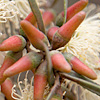Eucalyptus spathulata (Swamp Mallet, Narrow-leaved Gimlet) is a medium-sized tree that reaches a height of 5-10 m. It is conspicuous in its narrow (0.5 cm) spatula-shaped leaves which imparted it with its Latin name, which is also commonly used. Eucalyptus oil which is used mainly in medicine can be extracted from its leaves.
The young seedling has 2-3 pairs of opposite juvenile leaves, followed by alternate leaves.
The bark of Swamp Mallet is red and shiny, such that it is conspicuous in its surroundings. There are individuals whose trunk color is reminiscent of Arbutus. Swamp Mallet belongs to a group of Eucalyptus species that are called Mallet in Australia. This indicates that they have a single trunk which divides into several branches near the ground. The main trunk usually does not reach a height of more than 1 m. In Australia, it is used for firewood and for fence posts.
The inflorescence usually has 7 flowers. The blossoming buds are cylindrical, pink-orange. The operculum is elongated and straight stamens are concealed underneath. When the flower opens, the operculum, which is constructed from the petals, is shed, and the stamens impart the bloom a white color. The flowers contain large amounts of nectar and serve as a rich source of food for honeybees during the summer.
In Australia the tree blooms from December to March, and in Israel, which is located in the Northern Hemisphere, it blooms in the same season and in the parallel months: July-August. The fruit is conical.
Swamp Mallet originates from the southwestern corner of Australia, in the state of Western Australia, where it is endemic to the region within the wheat-belt east of the city of Perth.
The climate in its place of origin is Mediterranean dry (cool and rainy winter and hot and dry summer), and the amount of precipitation reaches 300-450 mm. In its natural habitat, Swamp Mallet is common in clay and sandy soils (including those originating from limestone), and it is resistant to salinity and to transient flooding.
Since Swamp Mallet is resistant to drought, limestone and salinity, it was planted in Israel mainly in the Northern Negev and is found mainly in groves and limans. In Israel it thrives on Loess and sandy soils in areas where the annual precipitation is 200-300 mm or even less.
The sites where Swamp Mallet trees can be seen are large: in a liman on road no. 40 on the northeastern side between the Tlalim Junction and Halukim (especially conspicuous with their red bark), in Lahav Forest east of the dirt road between the eastern entrance to Lehavim and the road that accesses Dvir and Lahav, in the region of Kibbutz Nir-Oz, in the acclimatization park east of the Omer Industrial Area, in Yatir, in Arad Park and in additional groves and forests.
In Australia there is a different sub-species with a shrub-like appearance which is more resistant to salinity. This sub-species was not brought to Israel.
Written by Zvi Avni







